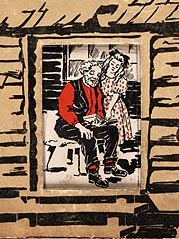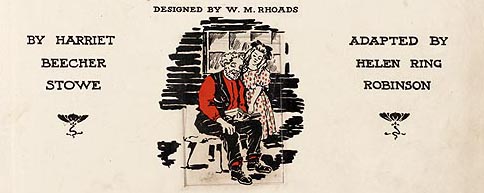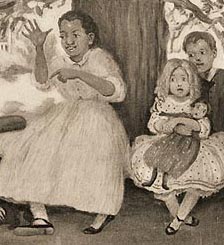DETAIL:
Cover with "Open" Door

This is easily the most lavish adaptation of Uncle Tom's Cabin we have found. The name listed first on its title page is the designer's, whose contribution includes a hole in the front cover inviting readers through the door of Tom's cabin, and an over-sized page layout featuring three different kinds of illustrations, fifty in all. It seems safe to say that only well-to-do families could have bought it, though its preface emphasizes that the reason to read Stowe's story "now" is to teach America's children "sympathy for the poor and wretched, whether black or white," so that they will grow up into men and women who will work toward "the dawn of a new Emancipation morning."
The message sent by the text, though, is a mixed one. While it lists some "dreadful things about slavery," it adds immediately that "there were some pleasant things as well." While it says (on page 44) "black children are very much like white ones," it also describes (on page 24) the "funny sight [Tom's] youngsters were, as they ate their cakes and smacked their lips, and rolled about on the floor in a tangle of sticky griddle cakes and yet more sticky darkeys."
Unlike Stowe's ending, in this adaptation none of the freed slaves leave for Africa, and it actually includes the only illustration of Topsy in Vermont we have found in any edition of Uncle Tom. The account of Topsy's place in that community, however, maintains a clear sense of racial difference: "the children of that staid New England village . . . found Topsy a constant wonder and delight" (page 185).
Its length is slightly less than one-fifth of Stowe's text. It consistently minimizes the Christian elements of the original story. The longest interpolation is a description in Chapter 5 of "the Underground Railroad."
Uncle Tom's Cabin for Children Designed by W. M. Rhoads
By Harriet Beecher Stowe | Adapted by Helen Ring Robinson
(Philadelphia: The Penn Publishing Company, 1908)


DETAIL:
Topsy in Vermont
